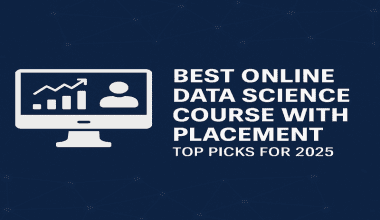Summary: This blog explores 9 of the most popular Data Science tools in 2024, including Python, R, SQL, and Apache Spark. We delve into their strengths and showcase real-world applications across various industries, from finance and healthcare to retail and social media.
Introduction
Data Science has become the backbone of innovation across industries. From optimizing marketing campaigns to predicting financial trends, data-driven insights are crucial for success in today’s world. But wielding this power requires the right tools. Here, we delve into nine of the most popular Data Science tools for 2024 and explore their real-world applications.
1. Python: The Undisputed King
The king of Data Science, Python offers readability, vast libraries (Pandas, Scikit-learn, Matplotlib), and a supportive community. It tackles data cleaning, analysis, machine learning, and visualization across finance, healthcare, and retail.
Pandas: Streamlines data manipulation and analysis, allowing for efficient cleaning, transformation, and exploration.
Scikit-learn: Provides a comprehensive toolbox for Machine Learning tasks, from regression to classification and clustering.
Matplotlib and Seaborn: Create stunning data visualizations to communicate insights effectively.
Applications: Python empowers data scientists across domains.
Finance: Analyze market trends, predict stock valuations, and develop algorithmic trading models.
Healthcare: Analyze patient data to personalize treatment plans, identify disease outbreaks, and accelerate drug discovery.
Retail: Build recommendation engines, optimize product placement, and predict customer behavior.
2. R: The Statisticians’ Haven
A statistician’s haven, R excels in statistical computing and graphics. It boasts a rich suite of statistical functions and visualizations, making it ideal for complex modeling in bioinformatics, social sciences, and market research.
Statistical Analysis: Offers a rich suite of statistical functions and tests, making it ideal for hypothesis testing and complex modeling.
Data Visualization: Creates high-quality visualizations, including advanced statistical plots and interactive graphics.
Applications: R excels in tasks demanding in-depth statistical analysis.
Bioinformatics: Analyze genetic data, identify disease markers, and model biological processes.
Social Sciences: Conduct surveys, analyze social media data, and understand human behavior patterns.
Market Research: Analyze consumer preferences, segment target audiences, and forecast market trends.
3. SQL: The Language of Databases
The language of databases, SQL allows data scientists to retrieve and manipulate data from relational databases, the most common storage format. It forms the foundation for data-driven operations in CRM, supply chain management, and web analytics.
Retrieve Data: Extract specific data subsets from databases for analysis.
Manipulate Data: Filter, join, and aggregate data to prepare it for further analysis.
Applications: SQL forms the bedrock of data-driven operations in various sectors.
Customer Relationship Management (CRM): Analyze customer interactions, identify churn factors, and personalize marketing campaigns.
Supply Chain Management: Track inventory levels, optimize logistics, and forecast demand.
Web Analytics: Analyze website traffic, user behavior, and identify areas for improvement.
4. Apache Spark: Taming the Big Data Beast
Designed for big data, Spark distributes processing across computers, enabling faster analysis of massive datasets. It empowers data scientists working with real-time data in IoT, fraud detection, and social media analytics.
Distributed Processing: Spreads data processing tasks across clusters of computers, accelerating computations on large datasets.
Real-time Analytics: Processes streaming data in real-time, enabling immediate insights and faster decision-making.
Applications: Spark empowers data scientists working with colossal datasets.
Internet of Things (IoT): Analyze sensor data from connected devices in real-time, monitor performance, and predict issues.
Fraud Detection: Analyze transaction patterns to identify fraudulent activities in real-time.
Social Media Analytics: Analyze social media data in near real-time to understand trends and public sentiment.
5. TensorFlow: Building the Brains of AI
A leading deep learning framework, TensorFlow allows building and training complex neural networks for tasks like image recognition, natural language processing, and recommendation systems. It fuels self-driving cars, medical diagnosis applications, and computer vision.
Neural Network Development: Construct and train complex deep learning models for tasks like image recognition, natural language processing, and recommendation systems.
Scalability: Supports deployment on various platforms, from cloud computing to mobile devices.
Applications: TensorFlow fuels cutting-edge AI applications.
Self-driving Cars: Analyze sensor data to navigate roads, recognize objects, and make real-time decisions.
Medical Diagnosis: Assist doctors in analyzing medical images for disease detection and treatment planning.
Computer Vision: Develop applications for object detection, facial recognition, and image segmentation.
6. Tableau: The Art of Data Storytelling
The data storytelling champion, Tableau simplifies data visualization for everyone. Its user-friendly interface empowers creation of interactive dashboards for sales, marketing, and human resources, facilitating clear communication and data exploration.
Interactive Dashboards: Create dynamic dashboards that allow users to explore data and uncover insights visually.
Data Sharing: Easily share visualizations with stakeholders to facilitate communication and decision-making.
Applications: Tableau empowers effective data communication across industries.
Sales and Marketing: Create compelling dashboards to track sales performance, marketing campaign effectiveness, and identify sales opportunities.
7. Power BI: Democratizing Data Insights
Microsoft’s business intelligence platform, Power BI, offers user-friendly data visualization and collaboration tools. Drag-and-drop functionalities and seamless integration with Microsoft products make it ideal for data analysis in finance, operations, and customer service within businesses of all sizes.
Data Visualization: Create interactive reports and dashboards with a user-friendly drag-and-drop interface.
Collaboration: Seamless integration with other Microsoft products facilitates collaboration and data sharing within organizations.
Applications: Power BI empowers Data Analysis within businesses of all sizes.
Finance: Analyze financial data, track key performance indicators (KPIs), and create reports for financial planning and budgeting.
Operations: Monitor production processes, identify bottlenecks, and optimize operational efficiency.
Customer Service: Analyze customer feedback data to improve customer satisfaction and identify areas for improvement.
8. Jupyter Notebook: The All-in-One Workstation
The all-in-one workstation, Jupyter Notebook, fosters a collaborative environment. It integrates code, text, and visualizations, making data exploration, model development, and sharing analysis reproducible. Jupyter Notebook serves educators, researchers, and data scientists in various tasks.
Code, Text, and Visualization Integration: Combine code, explanations, and visualizations within a single document, making analysis reproducible and shareable.
Interactive Exploration: Experiment with code and data in real-time, accelerating the process of data exploration and model development.
Applications: Jupyter Notebook serves as a versatile tool for various Data Science tasks.
Education and Training: Provides a platform for learning Data Science concepts and exploring datasets in a hands-on manner.
Research and Development: Facilitates rapid prototyping of Machine Learning models and exploration of new research ideas.
Data Cleaning and Exploration: Streamlines the process of data cleaning, transformation, and initial analysis.
9. Excel: The Spreadsheet Powerhouse
The spreadsheet powerhouse, Excel, remains a valuable tool for basic data cleaning, manipulation, and visualization. Its functionalities are particularly useful for non-technical audiences and initial data exploration in small businesses, non-profit organizations, and quick Data Analysis tasks.
Data Cleaning and Manipulation: Offers basic functionalities for data cleaning, sorting, and filtering.
Data Visualization: Creates basic charts and graphs to communicate insights effectively, particularly for non-technical audiences.
Applications: Excel serves as a practical tool for initial data exploration and basic analysis.
Small Businesses: Analyze sales data, track expenses, and create financial forecasts.
Non-profit Organizations: Analyze fundraising data, track program performance, and create reports for stakeholders.
Quick Data Exploration: Perform initial data exploration and visualization before diving into more sophisticated tools.
Conclusion
This list provides a glimpse into the vast array of Data Science tools available in 2024. The ideal tool selection depends on the specific project requirements, data size, and technical expertise. By mastering these tools and fostering a data-driven culture, organizations can unlock the power of data and make informed decisions that propel them forward.
Beyond the Tools
Remember, Data Science is more than just tools. It’s a blend of technical skills, domain knowledge, and critical thinking. The most effective data scientists are not just proficient in programming languages and frameworks, but also possess the ability to translate complex data into actionable insights.
As the Data Science landscape continues to evolve, staying updated with the latest tools and methodologies will be crucial for success.



